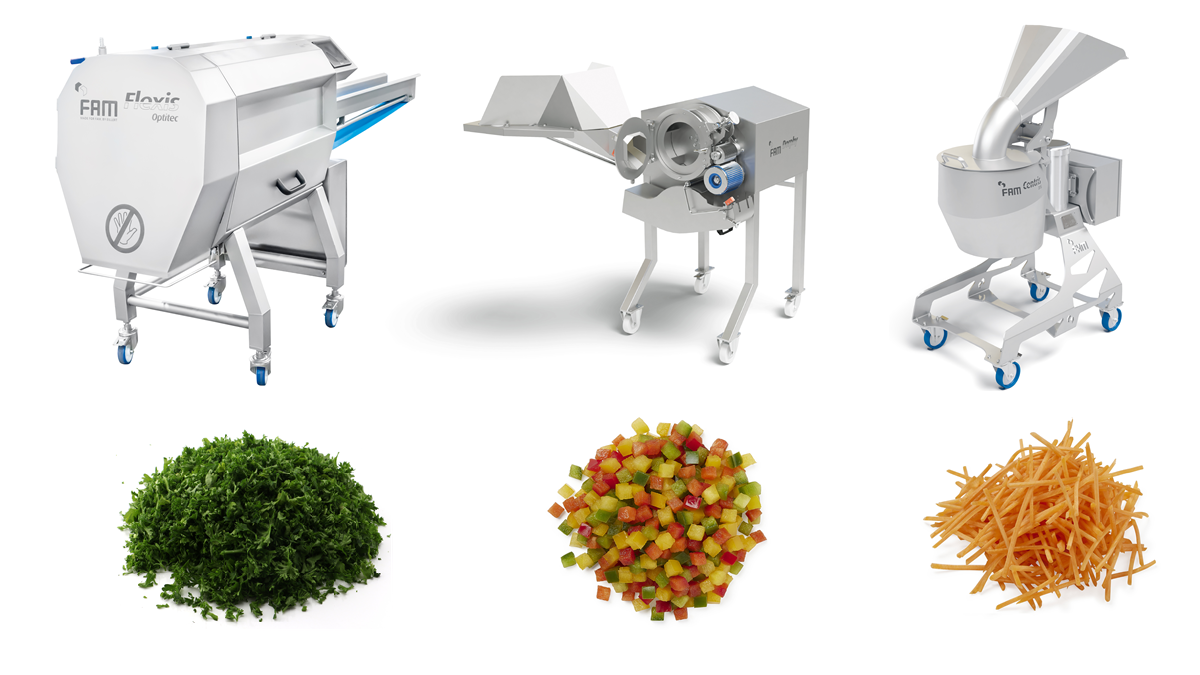Processing
How to cut frozen strawberries for an optimal result?
Cutting frozen strawberries is not an easy process. Anyone who has tried to cut frozen strawberries mechanically, knows it can be very challenging. But when using the right tools, this challenge can definitely be handled. FAM has gathered valuable experience in cutting frozen food over the past decades. This experience has led to the development of several high-quality cutting machines that can handle all varieties of frozen food. For frozen strawberries, for instance, the FAM Tridis?180 and FAM Tridis?240 are perfectly suited to do the job.
04 November, 2021
Cutting frozen strawberries is not an easy process. Anyone who has tried to cut frozen strawberries mechanically, knows it can be very challenging. But when using the right tools, this challenge can definitely be handled. FAM has gathered valuable experience in cutting frozen food over the past decades. This experience has led to the development of several high-quality cutting machines that can handle all varieties of frozen food. For frozen strawberries, for instance, the FAM Tridis180 and FAM Tridis240 are perfectly suited to do the job. According to Sven Boen, Sales manager for EMEA & LATAM at FAM, the most important thing is to start by setting realistic expectations. Before deciding on anything, you need to be aware that strawberries have many varieties and depending on where and how they grow, they will behave differently when being cut. So, there is not one single solution and setup that will fit all strawberry cutting needs. Before deciding on a machine and starting the production, one should always test it in the production environment in order to estimate all aspects of the processing. "Even under ideal circumstances, it is unrealistic to expect all perfectshaped cubes out of a natural spherical or irregular product. Depending on the final application, this might be more or less important. Of course, the product and the dice size will also influence the result. Take the example of dicing strawberries with a diameter of 45mm in 10x10x10mm dices; even with reasonably large strawberries for cutting, you would have 4 perfect and 10 imperfect cubes per slice, with a maximum of 4 perfect pieces per strawberry." The way the fruit has been frozen is also essential, he adds. Large blocks of frozen product sticking together will not yield a good result, whereas individual loose products will lead to better results. If a lot of ice is formed around the product, this will also show in the number of fines of the cut product. Only the tiniest pieces will be considered as waste, as most customers will consider even the incomplete dices as usable. Still, expectations must be realistic and in line with the end-product in mind. Another thing to keep in sight is that the appropriate temperature for cutting depends on the water content and Brix value. The Brix value tells you how much dissolved sugar is in a liquid solution. The higher the Brix value, the sweeter the liquid solution. "It is also vital to check the actual temperature of the product at the moment it is entering the cutting machine. Strawberries take up the room temperature very fast, so when the product leaves the freezer at - 15°C but has to travel over belts for a few minutes before reaching the cutting machine, the temperature may have changed by a few degrees. The higher the ambient temperature of the room, the faster the product temperature rises, which may cause the strawberries to become too soft to be cut properly," Sven Boen explains. "As with most frozen products, it is crucial to first cut the product manually with a knife. If you can cut through the strawberry fairly easily, the temperature is also suitable for the blades of the cutting machine. If this is impossible, you need to reevaluate the temperature. Realistically, the ideal temperature to cut uniformly tempered frozen strawberries is between -8° C and - 12° C depending on the sugar content. It is not recommended to cut the product at a temperature above -5° C as the strawberry will not be firm enough to produce perfectly shaped cubes." "The choice of the proper slicing knife depends, among others, on the cut size", Boen adds. The insertable slicing knife is the preferred solution if small cubes need to be produced, as it will create less ice powder. Application examples are 3mm cubes for baby food and 5mm cubes for yoghurt. Finally, testing starts with the first cut. One way of seeing if this goes well, is visually checking the inside of the drum during slicing. You will be able to see if the strawberries are bouncing off the slicing knife instead of going through nicely. If this happens, either the slicing blade is no longer in good condition, or your product is simply too cold. "Whoever thinks cutting frozen strawberries is a nobrainer, is very wrong. But thinking the opposite is equally wrong. Yes, it does require more thought, experience and high-quality material than one would think at first. But with the right choice of strawberries, the right equipment and some sound advice, you can succeed regardless of your specific application," they conclude. This information belongs to the article "More options for manufacturers" published in Frozen Food Europe magazine











